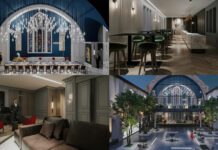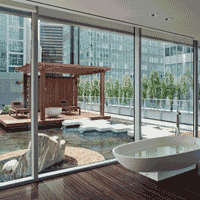Has your hotel spiced up the decor lately?
Something is amiss at the Grand Hyatt Kuala Lumpur: when travellers enter the shiny new hotel in Malaysia, set to open next January, they’ll be surprised. Instead of a ground-floor check-in area, one of four express elevators will whisk them up to the 40th-floor sky lobby. There, 360-degree views of downtown Kuala Lumpur, studded with skyscrapers, will spread before them like a giant photograph in a contemporary art museum.
“Waiting in the fantastic double-level loft space will be an open-plan check-in desk overlooking the specialty restaurants, cafés and bars below,” says Seattle-based Jin Koyama, associate senior project manager of WATG, the firm responsible for the breathtaking design.
Koyama says WATG, one of the world’s leading hospitality design firms, inverted the lobby placement to improve guest experience. Since the hotel is in the heart of the Kuala Lumpur City Center (KLCC) Central Park, there are a number of towers around the perimeter. Adjacent is the WATG-designed Mandarin Oriental tower, the KLCC Petronas Twin Towers (the second-highest buildings in the world) and the convention centre at the back. “As you can imagine, it can be overwhelming and even claustrophobic at the round level,” Koyama says. “But at the top, the space feels much more open and offers city views of central park and the skyscrapers.”
In December 2009, the Fairmont Pacific Rim in Vancouver unveiled its unusual exterior by architect James Cheng. Wrapped around two sides of the building’s façade is a million-dollar public art display, by New York-based U.K. artist Liam Gillick. It consists of a running line of repeated text: “Lying on top of a building the clouds looked no nearer than when I was lying on the street.” The text occupies floors five through 22 and provides a demarcation between the hotel and the additional 25 floors of luxury residential suites above.
Unexpected architectural and interior design flourishes are the vanguard of new hotels. These can be such striking ideas as swapping the site of the lobby, creating a funky exterior or subtler choices such as choosing furnishings wisely, rather than sourcing the cheapest goods on the market (savvy guests know the difference).
At the Pacific Rim, guests won’t be able to keep their hands off the modern furnishings, chosen for their textural qualities. Part of Cheng’s vision for the 337-room hotel, built to coincide with the Olympics, was to create a “sensuous modern aesthetic.”
“Everything a guest sees, touches, feels, smells and hears should pique and appeal to their senses,” he says of the hotel with interiors by Vancouver’s CHIL Group.
Touchy feely rooms feature chairs cloaked in butter-soft leather and 100-per-cent Italian cotton oversized Mascioni bath towels and linens. Walls are covered in sustainable walnut, while the marble and the fixtures in the cushy spa bathrooms are from Italy and Greece. All of the handcrafted room furniture is from Les Meubles Saint-Damase, a boutique manufacturer in Quebec. (Pacific Rim guests especially enjoy “the touch-lighting system, the TV in the mirror and the media panel at the desk,” reports Randy Zupanski, the Pacific Rim GM).
Though costs may have been cut on linens and the like, Zupanski explains how the Pacific Rim’s decadent design was strategic. “As our quality of life improves, it becomes more challenging for hoteliers,” he says. “Ten years ago, hotel beds were uncomfortable, pillows were so-so, the quality of the TV was average, then all of a sudden people started buying quality beds at home and flat-screens with sound systems — you can’t expect a hotel to offer less than that.”
The GM’s sentiment is echoed byWATG’s Koyama, a 20- year industry veteran. “Hotel/resort-design architects [have to] create extraordinary destinations for world-class clients; this will be a constant going forward.” He notes the pervasiveness of technology and its effect on interior design: “Only a short while ago, people didn’t have the Internet, cellphones or laptop computers; nor did they care about recycling, renewable energy and saving the Earth — these developments have greatly changed the way we design.”
And, even though finding good quality could cost more, it doesn’t mean it’s necessary to cut costs by ordering custom furniture from China. “Finding quality in China depends on the energy you put in controlling how it’s made.” During the construction of Pacific Rim’s furniture, the designers made frequent visits to the factory to monitor production.
“It would be no different if you were having [the goods] made in China,” Zupanski says. “The problem is that it’s so far away.” But, he notes that employing a middle person, to check production, can circumvent issues before the shipment arrives by boat.
At the W Hotel in Montreal’s Quartier International district, it’s all about the sensory experience from the getgo. In the entry way, guests are enveloped by a sexy lit canopy. Inside, the “living room”—asWcalls its lobby— is 3,000 square feet of contemporary cool. Deep, cosy sofas and seats are framed by a massive smoky-grey mirror. A glowing red welcome desk and concierge station is a progressive alternative to the staid version. The hotel, which offers 152 rooms, including 28 suites (five Wow and three Extreme Wow), is a prime example of how the lobby is an opportunity to make a first impression.
The fun continues in the rooms where LED-night tables glow by the beds like toadstools in a Tim Burton Wonderland redux. “The illuminated side tables were a unique way to add atmosphere,” says Claudia Emde, marketing manager at W Hotel. “The blue light accentuates the rest of the room,” she says, referring to the electric blue accents that are also carried into the corridors. “It’s just another fun and innovative way to play with lighting.”
“Play” might very well have been a directive for W Design, the interior team behind the cheeky rooms. In the Extreme Wow Suite an eggshell-coloured headboard resembles a slab of acrylic (it’s actually leather). “Leather is a durable, noble material that’s easy to keep clean,” Emde says of the choice.
The Extreme Wow Suite also has a residential feel, as though guests were spending a night at home. A curved black sofa and white leather cubes and chairs make a pretty tableau by the window. “The suite was made to reflect the feel and comfort of a loft,” Emde says. “She notes the sofa and cubes and chairs are sourced from Montreal-based Delta furniture, as the hotel is a large supporter of the community.
The W signature beds themselves flaunt feather-top mattresses, 350-thread-count Egyptian cotton sheets, goose-down comforters, white fur blankets and pillows. “Climbing into one of these beds is like sinking into the clouds,” Emde says. An actual photo montage of clouds on the wall plays into that, while fresh-cut flowers are a standard in every guestroom — it might seem a silly expense, but in a hotel, it’s the little things that count.





















